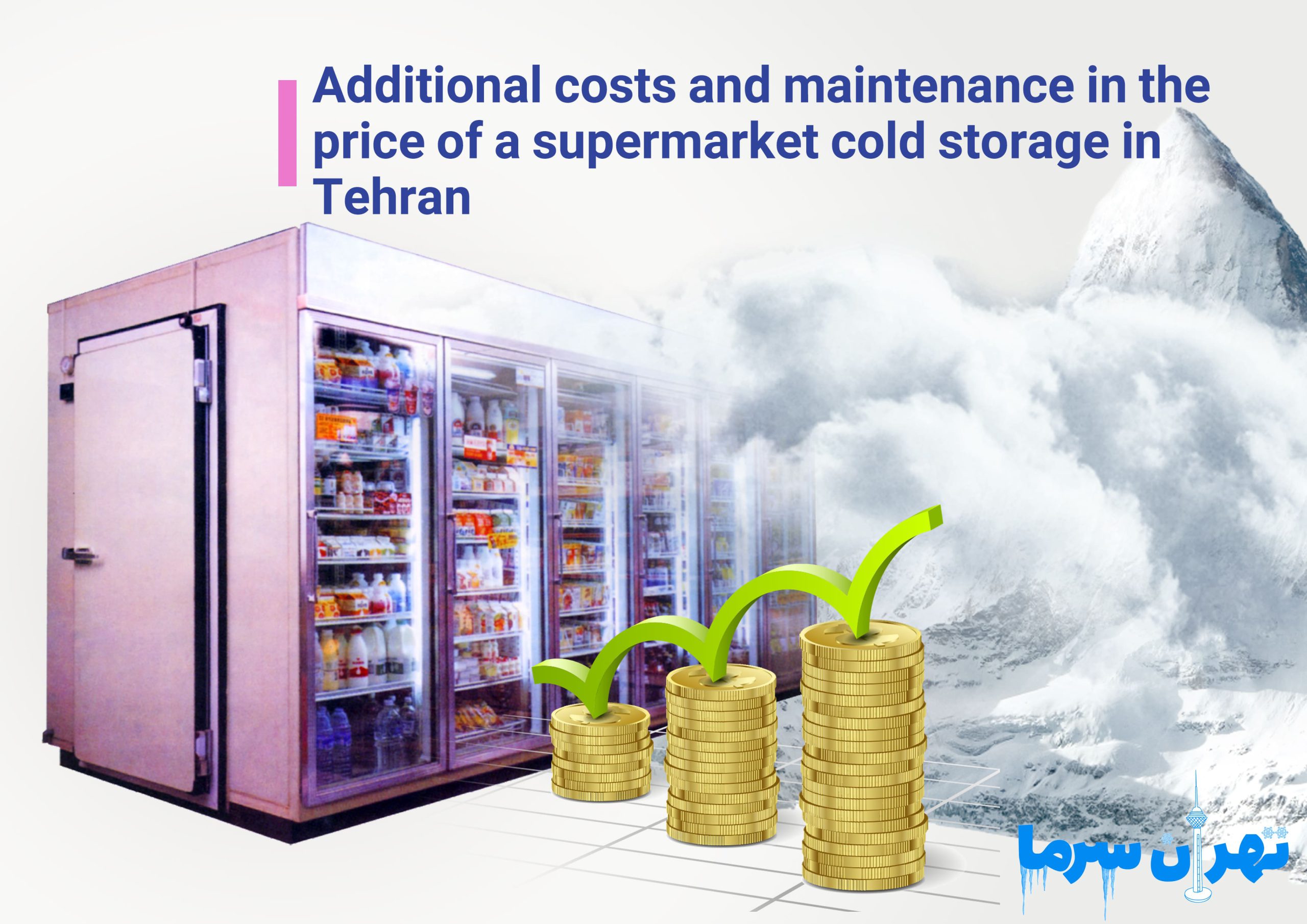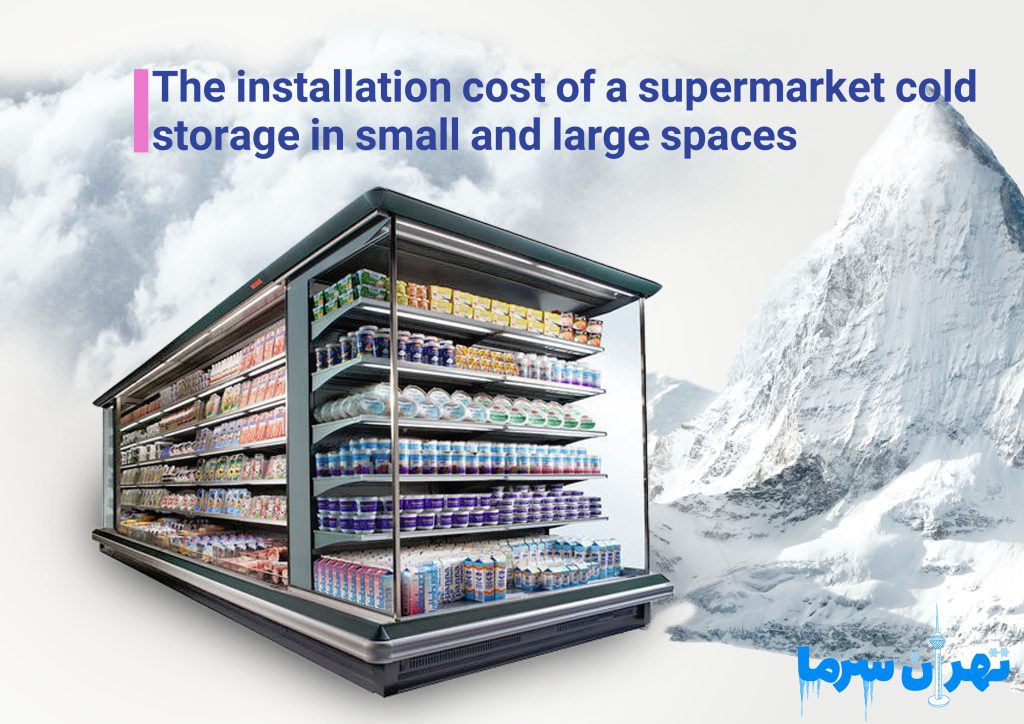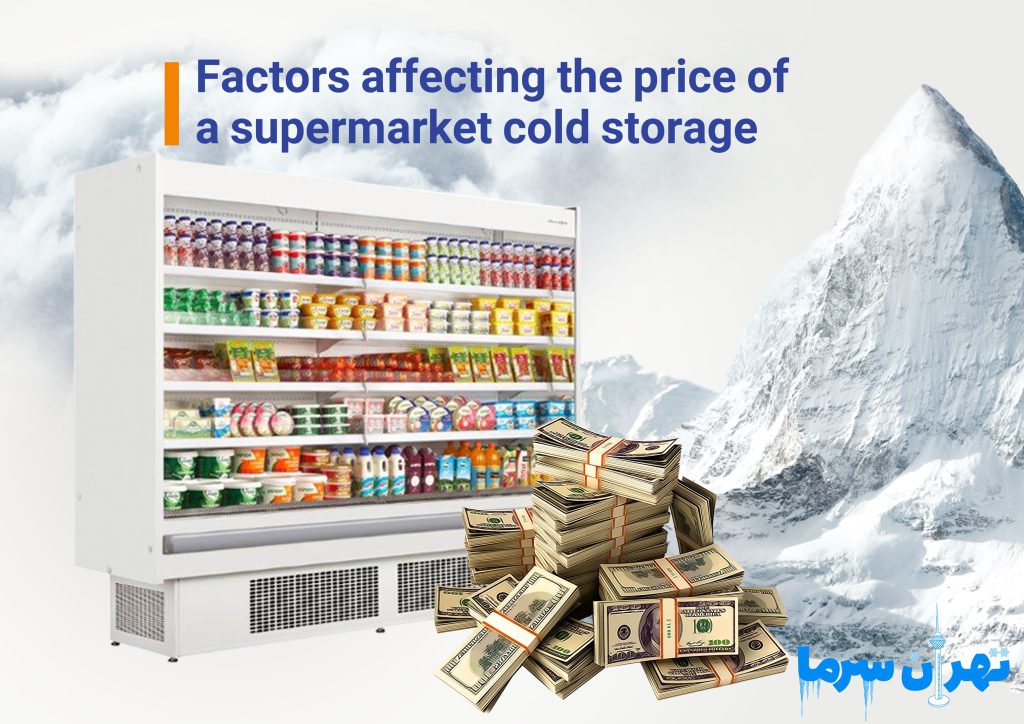Additional Costs and Maintenance in the Price of a Supermarket Cold Storage in Tehran

The price of a supermarket cold storage depends on various factors such as capacity, type of equipment, and the manufacturer’s brand. Additionally, the installation cost of a supermarket cold storage varies based on its dimensions, installation location, and technical complexities. Generally, the price of a supermarket cold storage in Tehran may differ from other cities due to higher labor and transportation costs.
Additional Costs of Installation and Setup
After purchasing a cold storage unit, there are costs associated with its installation and setup. Some of these costs include:
- Transportation and relocation: Depending on the size and weight of the cold storage unit, transportation costs may vary.
- Installation and setup: Specialized technicians are required for installing and adjusting refrigeration systems.
- Piping and electrical wiring: Additional costs may arise for the necessary piping and wiring to supply power and gas, depending on the store’s location and structure.
- Electricity and Energy Costs
Cold storage units consume a significant amount of electricity due to continuous use of compressors, condensers, and cooling systems. Factors influencing energy consumption include:
- Type of motor and compressor: Inverter or energy-efficient motors can reduce electricity costs.
- Insulation and sealing: Properly insulated cold storage units absorb less heat and consume less electricity.
- Peak consumption hours: Using electricity during peak hours can increase costs.
- Maintenance and Repair Costs
Regular maintenance of cold storage units not only extends their lifespan but also prevents sudden breakdowns and additional expenses. Some maintenance costs include:
- Periodic servicing: Replacing filters, checking refrigerant gas, and adjusting compressors should be done regularly.
- Potential repair costs: Components such as thermostats, compressors, and fans may require replacement over time.
- Refrigerant gas leaks: In case of leaks, costs for gas refilling and system repair will increase.
- Sanitary Maintenance Costs
In a supermarket, maintaining hygiene standards for stored products is essential. Costs related to this include:
- Periodic cleaning of cold storage: Cleaning the interior to prevent contamination and bacterial growth is necessary.
- Disinfection and odor control: Using disinfectants to prevent food spoilage and maintain product quality is recommended.
- Impact of Location and Tehran’s Climate on Costs
Tehran’s unique climate conditions affect cold storage expenses:
- Hot summers and increased cooling needs: During hot months, compressors endure more pressure, increasing electricity costs.
- Air pollution and its impact on equipment parts: Airborne particles and dust can damage condensers and fans, leading to higher repair and maintenance expenses.
Installation Costs of Supermarket Cold Storage in Small and Large Spaces
In small spaces, due to size and structural limitations, more compact and integrated refrigeration systems are typically used. These cold storage units are usually pre-fabricated, allowing for faster and simpler installation. Because of their smaller size, they consume less energy than larger models, reducing operational costs. Additionally, selecting the right installation location in small spaces is crucial, as improper placement can lead to increased energy loss and reduced equipment efficiency. During installation, assessing insulation type and optimizing cooling performance is essential to prevent temperature fluctuations and energy wastage.
Conversely, installing cold storage in large spaces requires a more complex and comprehensive process. Due to the larger storage area, high-capacity refrigeration equipment and advanced control systems are necessary. One major challenge in such environments is efficiently distributing cold air to ensure all areas maintain the required temperature while avoiding uneven cooling zones. Additionally, energy infrastructure must be carefully planned to minimize electricity costs while ensuring long-term system stability.
Apart from cold storage dimensions, the type of equipment used significantly affects installation costs. Some refrigeration systems feature advanced technologies that provide precise temperature and humidity control, making them ideal for large cold storage facilities requiring long-term food preservation. On the other hand, smaller cold storage units may use simpler equipment with lower installation costs but require more frequent maintenance to maintain efficiency.
Another factor influencing installation costs is the environmental and climatic conditions of the installation site. In areas with high temperatures for most of the year, refrigeration equipment consumes more energy to maintain the desired internal temperature. Therefore, proper system design and high-quality insulation materials are crucial. Using high-quality insulation can significantly reduce energy consumption and increase equipment lifespan. In colder regions, different challenges arise, such as requiring specific adjustments to prevent freezing in certain parts of the cold storage unit.
Installing cold storage of any scale requires adherence to health and safety standards. During installation, in addition to technical aspects such as power supply and ventilation systems, hygiene considerations must also be addressed to prevent contamination and maintain product quality. Using corrosion-resistant materials, properly sealing gaps to prevent air and moisture infiltration, and implementing adequate ventilation systems all contribute to improving cold storage performance and efficiency.
How to Reduce the Price of a Supermarket Cold Storage?
Reducing cold storage costs in supermarkets is a key concern, and by carefully analyzing various aspects of these systems, effective solutions can be found. The impact of cold storage costs is not limited to the purchase price; factors such as energy consumption, maintenance expenses, equipment efficiency, and space optimization also play a role in determining the final costs. In many cases, making informed decisions at the selection and setup stage can significantly reduce overall expenses. Assessing the store’s actual needs, choosing optimal technologies, managing energy consumption, and implementing preventive maintenance strategies are some of the effective ways to reduce cold storage costs.
One important factor affecting cold storage costs is selecting the right equipment based on the store’s requirements. In some cases, using oversized systems increases initial and operational costs, whereas choosing an appropriately sized system based on product volume and type can significantly reduce expenses. Considering technical specifications, energy consumption, and equipment quality plays a crucial role in determining total costs. In many cases, newer and more energy-efficient technologies may have a higher initial price but reduce overall costs in the long run by lowering energy consumption and increasing durability.
Energy management is another key factor in reducing cold storage costs. Choosing high-efficiency equipment and implementing energy optimization systems can significantly reduce electricity expenses. Precise temperature settings, proper insulation, and minimizing frequent door openings can enhance energy efficiency. In some cases, using smart temperature control systems that automatically adjust cooling levels can greatly improve energy optimization.
Proper maintenance and regular servicing also play a vital role in reducing cold storage costs. Many additional expenses result from sudden breakdowns and inadequate equipment maintenance. Periodic inspections, filter cleaning, ensuring proper compressor function, and checking for potential leaks are necessary actions that can extend equipment lifespan and reduce repair and replacement costs. Poor maintenance can lower efficiency, increasing energy consumption and long-term expenses.
Space optimization and efficient use of cold storage capacity can also help reduce costs. Poor product arrangement inside the cold storage unit can restrict airflow, putting extra strain on the cooling system and increasing energy consumption. Implementing proper storage methods and ensuring adequate airflow can enhance cold storage efficiency and prevent unnecessary costs.
Additionally, assessing environmental conditions and selecting an appropriate installation location significantly impact expenses. Installing the cold storage unit in a location with minimal heat exchange with the external environment can reduce energy consumption. If the installation site is not suitable, refrigeration equipment may have to operate under higher pressure, leading to increased energy costs and reduced equipment lifespan.
Additional Costs and Maintenance in the Price of a Supermarket Cold Storage
Additional costs and maintenance play a significant role in the final price of a supermarket cold storage, including energy consumption, periodic servicing, potential repairs, replacing worn-out parts, and expenses related to insulation and ventilation. Electricity consumption is one of the most critical ongoing costs, varying depending on equipment efficiency and usage. Regular maintenance, such as compressor checks, condenser cleaning, and refrigerant system inspections, extends the cold storage’s lifespan and reduces long-term expenses. Additionally, using energy-efficient equipment and implementing energy-saving strategies, such as installing proper seals and precise temperature settings, helps control operational costs and prevents unnecessary increases.
Factors Affecting the Price of a Supermarket Cold Storage
The price of a supermarket cold storage is influenced by various factors, including storage capacity, insulation quality, compressor efficiency, temperature control technology, and equipment brand. Additionally, installation and maintenance costs, local climate conditions, and electricity consumption significantly impact the final price. Choosing energy-efficient equipment with long lifespans can reduce long-term expenses and enhance investment returns.
Managing Supermarket Cold Storage Costs with Tehran Sarma Engineering Company
Managing supermarket cold storage costs effectively is possible with the cooperation of Tehran Sarma Engineering Company, which offers advanced equipment, optimized designs, and energy-saving solutions to reduce initial and operational costs.
For more information, visit the Tehran Sarma website or contact:
📞 09121906418 | 02177972256
The price of a supermarket cold storage is determined by factors such as capacity, equipment quality, and refrigeration system type. Additionally, installation costs vary based on technical requirements and project location. Generally, the price of a supermarket cold storage in Tehran may differ from other cities due to transportation and installation labor costs.
Source:
https://unitedinsulated.com/




 سردخانه
سردخانه برق
برق کمپرسور
کمپرسور کمپرسور بیتزر
کمپرسور بیتزر کمپرسور کوپلند
کمپرسور کوپلند کمپرسور بوک
کمپرسور بوک کمپرسور دانفوس
کمپرسور دانفوس کمپرسور منیروپ دانفوس
کمپرسور منیروپ دانفوس کمپرسور امبراکو
کمپرسور امبراکو کمپرسور پاناسونیک
کمپرسور پاناسونیک کمپرسور سابکول
کمپرسور سابکول کمپرسور کوپلند
کمپرسور کوپلند کمپرسور اسکرال کوپلند
کمپرسور اسکرال کوپلند کمپرسورفراسکلد
کمپرسورفراسکلد کمپرسور رفکامپ
کمپرسور رفکامپ کمپرسور اسکرال دانفوس
کمپرسور اسکرال دانفوس گاز مبرد
گاز مبرد گاز R22
گاز R22 گاز R134
گاز R134 گاز R404
گاز R404 گاز R407
گاز R407 گاز R410
گاز R410 گاز R508
گاز R508 کندانسور هوایی
کندانسور هوایی اواپراتور
اواپراتور اواپراتور آرشه
اواپراتور آرشه اواپراتور صابکول
اواپراتور صابکول اواپراتور آسه
اواپراتور آسه اواپراتور نیک
اواپراتور نیک اواپراتور آرتک
اواپراتور آرتک اواپراتور نوین
اواپراتور نوین اواپراتور تبادل کار
اواپراتور تبادل کار درب
درب ساندویچ پنل
ساندویچ پنل فن سردخانه
فن سردخانه روغن کمپرسور سانیسو
روغن کمپرسور سانیسو متعلقات سردخانه
متعلقات سردخانه